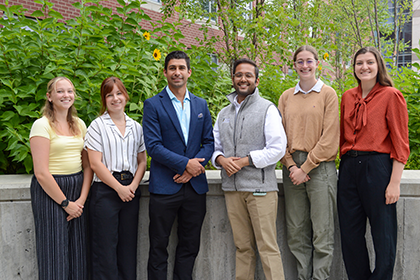In a recent paper, titled “Vasohibin Inhibition Improves Myocardial Relaxation
in Heart Failure with Preserved Ejection Fraction,” Matthew Caporizzo, Ph.D., assistant professor of Molecular Physiology & Biophysics, along with researchers at the University of Pennsylvania, have created a powerful small molecule vasohibin inhibitor (VASHi) to block MTN detyrosination in live animals. Detyrosination is the enzymatic removal of the tyrosine (an amino acid that is used by cells to build proteins) residue from the C-terminal end of tubulin (a protein that forms microtubules), which makes the microtubules sticky, impeding the heart cells from relaxing properly.

Caporizzo Lab team (L-R: Melinda Wetzel, Jessi Bak, Matthew Caporizzo, Ph.D., Raihan Kabir, Julia Shrier, Emmaleigh Hancock)
Revolutionary Small Molecule Inhibitor VASHi Shows Promise in Treating Heart Failure with Preserved Ejection Fraction (HFpEF)
Heart disease, which includes heart failure, has been the leading cause of death in the United States since 1950. Among the estimated 5 million Americans diagnosed with heart failure (HF), approximately 50% have heart failure with preserved ejection fraction (HFpEF). HFpEF occurs when the heart's left ventricle becomes stiff and fails to relax properly during the filling phase (diastole). Although the heart pumps out a normal percentage of blood with each contraction (ejection fraction), the overall blood volume pumped is deficient due to insufficient ventricular filling. Scientists at the Larner College of Medicine and the Perelman School of Medicine at the University of Pennsylvania have recently made a groundbreaking discovery to address this disease, and partnering with a small pharmaceutical company, MT-Act, they have developed a new small molecule inhibitor to repair the failing heart’s microtubule network (MTN).
In a recent paper, titled “Vasohibin Inhibition Improves Myocardial Relaxation
in Heart Failure with Preserved Ejection Fraction,” Matthew Caporizzo, Ph.D., assistant professor of Molecular Physiology & Biophysics, along with researchers at the University of Pennsylvania, have created a powerful small molecule vasohibin inhibitor (VASHi) to block MTN detyrosination in live animals. Detyrosination is the enzymatic removal of the tyrosine (an amino acid that is used by cells to build proteins) residue from the C-terminal end of tubulin (a protein that forms microtubules), which makes the microtubules sticky, impeding the heart cells from relaxing properly. Caporizzo, using obese rats as models, found that they had more tubulin detyrosination, which was linked to poor heart relaxation, a larger left atrium, and heart enlargement while maintaining a normal left ventricle ejection fraction, matching human HFpEF characteristics and making them perfect subjects for VASHi intervention.
“Their results demonstrate that microtubule detyrosination likely plays a significant role HFpEF pathology, and inhibiting VASH could provide a new therapeutic strategy,” stated Caporizzo.
His team discovered that their VASHi improved the diastolic function in obese rats. Specifically, VASHi treatment reduced relaxation times compared to untreated subjects, demonstrating that reducing detyrosination helps the heart relax. In addition, left ventricular end-diastolic pressure (LVEDP), an important clinical indicator of pathological stiffening, tended to be lower with VASHi.
Caporizzo and colleagues’s findings may be integral in the treatment of HFpEF in people, a condition for which there are limited therapeutic options. After successful trials in rats, they tested VASHi on isolated human heart cells from non-failing and failing hearts and found VASHi also improved relaxation in failing human heart cells. Excitingly, this suggests that VASHi could be a potential treatment to reduce stiffness and improve heart relaxation in HFpEF. There are currently limited treatment options available to address HFpEF, but none of these target the stiffness of the myocardium directly. Thus, the VASHi compound represents a novel step in the management of HFpEF which could even be extended to other forms of heart failure where stiffening of the heart is well documented.
Caporizzo and colleagues have demonstrated VASHi improves diastolic performance in failing human cardiomyocytes which represents a significant step in the management of HFpEF and other forms of heart failure by targeting the hearts stiffness.
Watch Matt Caporizzo, Ph.D., discuss VASHi with ABC22 & FOX44.